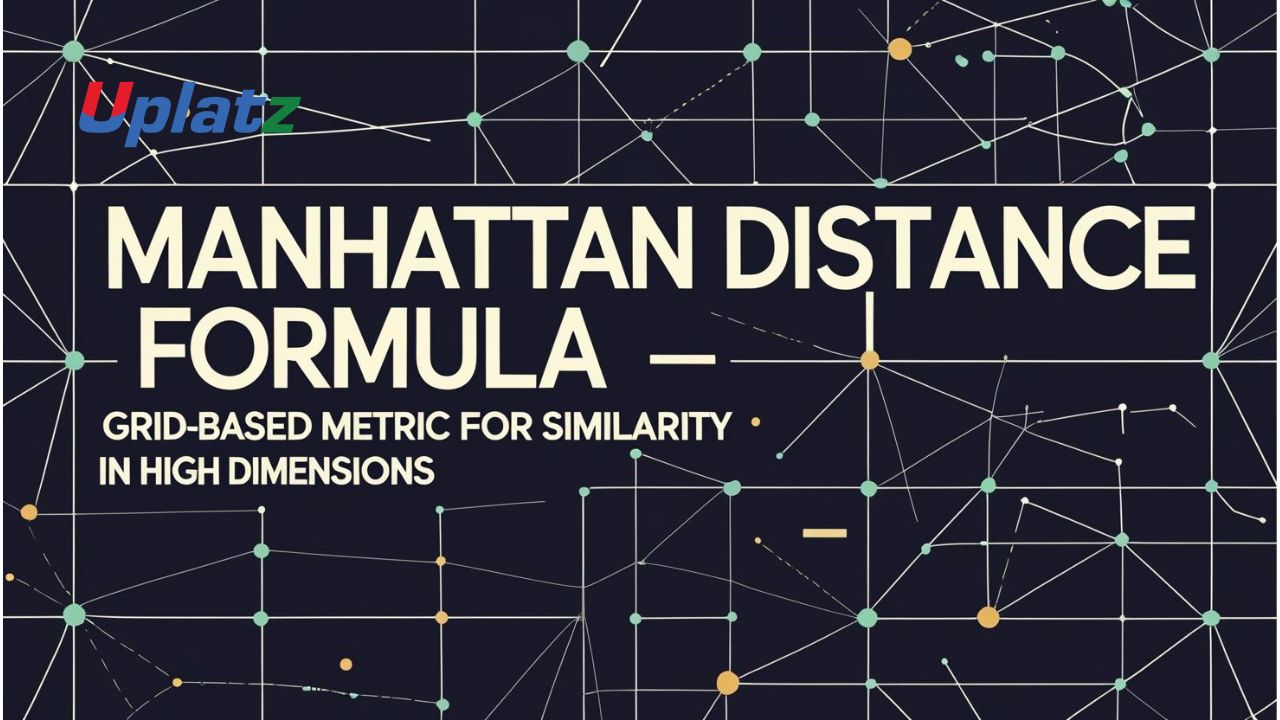 🔹 Short Description:
🔹 Short Description:
The Manhattan Distance formula measures the absolute difference between points across each dimension. It mimics the way you’d move through a city grid—up, down, left, or right—rather than diagonally.
🔹 Description (Plain Text):
The Manhattan Distance, also known as Taxicab Geometry or L1 norm, is a popular mathematical distance metric that calculates the total absolute difference between coordinates of two points. This formula is particularly valuable in high-dimensional spaces and settings where movement is constrained to a grid-like path (e.g. urban navigation, matrix traversal, or grid-based machine learning problems).
📌 Formula (for two points p and q in n-dimensional space):
D(p, q) = |p₁ – q₁| + |p₂ – q₂| + … + |pₙ – qₙ|
Where:
- p = (p₁, p₂, …, pₙ) and q = (q₁, q₂, …, qₙ) are two points in n-dimensional space
- |pᵢ – qᵢ| is the absolute difference between the i-th dimensions
- Unlike Euclidean Distance, no squaring or square root is involved
🏙️ Why It’s Called “Manhattan” Distance
The term originates from how movement occurs in a grid-based city like Manhattan, New York. Instead of moving diagonally (as a bird might fly), a taxi would have to travel along straight lines — going north/south and east/west — just like the blocks of a city. The Manhattan Distance reflects the sum of the absolute differences along each axis, just as a car would tally up its turns and blocks covered.
Example (2D case):
Point A = (1, 2), Point B = (4, 6)
Manhattan Distance = |4 – 1| + |6 – 2| = 3 + 4 = 7
This metric emphasizes individual axis-aligned differences and is computationally simpler than calculating a diagonal (Euclidean) distance.
💼 Real-World Applications
- Machine Learning – KNN, Clustering
In algorithms like K-Nearest Neighbors (KNN) and K-Means, Manhattan Distance can replace Euclidean Distance to improve performance, especially when dealing with high-dimensional data or sparse matrices. - Recommendation Systems
When comparing user profiles, the Manhattan Distance offers a clearer distinction in some cases where differences in preferences are axis-aligned. - Computer Vision
For simple image comparison and object detection tasks where pixels are laid out on a grid, Manhattan Distance is a computationally lighter alternative. - Game Development
In grid-based games (e.g., tile maps, board games, chess), pathfinding uses Manhattan Distance to evaluate proximity between entities. - Finance and Risk Modeling
Used in portfolio analysis where differences in assets or time series data are compared based on absolute changes rather than squared deviations. - Robotics and Urban Planning
Used in pathfinding algorithms for drones, robots, or delivery routing in structured spaces where diagonal movement is not possible.
🧠 Key Insights & Comparisons
- Contrast with Euclidean Distance:
Euclidean gives the shortest path (hypotenuse), while Manhattan gives the step-wise path. For example, in high-dimensional, sparse, or categorical datasets, Manhattan often performs better than Euclidean. - L1 vs. L2 Norm:
- Manhattan Distance uses the L1 norm, summing absolute differences.
- Euclidean Distance uses the L2 norm, summing squared differences and taking a square root.
- L1 is more robust to outliers and more interpretable in some real-world situations.
- Interpretability:
In many cases, especially involving costs or time, Manhattan Distance is easier to interpret — each unit difference represents a step or cost in one direction. - High-Dimensional Suitability:
Manhattan Distance mitigates some problems of the “curse of dimensionality” seen in Euclidean space. It avoids over-penalizing large values and performs better when features are not correlated.
⚠️ Limitations
Despite its benefits, Manhattan Distance has certain limitations:
- Not rotation invariant
Unlike Euclidean Distance, Manhattan Distance changes if you rotate the coordinate system. - Not suitable for circular or spatial proximity tasks
In geographic mapping or when curved surfaces are involved, Euclidean or geodesic distances are better suited. - Ignores correlation between features
Like many other distance metrics, it assumes features are independent unless otherwise encoded. - Sensitive to scaling
Requires normalization when dimensions have vastly different ranges or units to prevent domination by any one feature. - May not align with intuitive human similarity
For example, in natural language tasks or image recognition, deeper context might be needed beyond grid-based differences.
✅ When to Use Manhattan Distance
- Your data is sparse (e.g., lots of 0s in vectors)
- Features are independent and uncorrelated
- Movement or comparison is grid-based or axis-aligned
- You’re working in high-dimensional space
- Interpretability and computational simplicity are priorities
- Your model is sensitive to outliers or skewed distributions
🔍 Visual Representation
Imagine a grid or matrix. If you want to move from the bottom-left corner to the top-right, you must move across rows and columns. This structure is at the core of Manhattan Distance logic. In comparison, a straight diagonal shortcut (as Euclidean Distance would allow) might be physically impossible or unrealistic in many real-world use cases.
🧩 Bonus: Manhattan Distance in NLP
Though less common than cosine similarity or Euclidean metrics, Manhattan Distance can be used with TF-IDF vectors or word embeddings to calculate textual dissimilarity. For specific problems like bag-of-words sentiment analysis, it can offer a rough but effective distance measure.
📎 Summary
- Formula: Sum of absolute differences
- Best for: High-dimensional, sparse, grid-based problems
- Advantages: Interpretable, efficient, outlier-resistant
- Drawbacks: Not rotation-invariant, ignores semantics
Manhattan Distance is a trusted ally in many data science, robotics, and AI projects where linear paths and performance matter more than perfect geometric symmetry.
🔹 Meta Title:
Manhattan Distance Formula – Grid-Based Metric for Machine Learning & AI
🔹 Meta Description:
Learn how the Manhattan Distance formula measures axis-aligned similarity between points. Ideal for high-dimensional data, robotics, and grid-based systems, it’s a powerful L1 norm metric used in KNN, clustering, and pathfinding.
